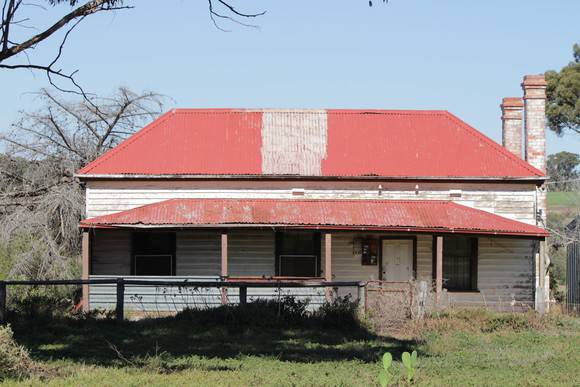| Back to search results » | Back to search page » |
|
HO129 - House - 398-428 Exford Road, Weir Views
Location398-428 Exford Road WEIR VIEWS, MELTON CITY LevelIncluded in Heritage Overlay |
|
Statement of Significance
What is significant?
The Federation period weatherboard house at 398-428 Exford Road, Weir Views. The weatherboard house originally had a symmetrical facade. It was
later extended at the northern end in a similar manner to the original
section so that the entry is located off-centre (towards the southern
end). Two red brick chimneys survive to the southern elevation and the
roof is clad in corrugated sheet metal. The original double hung sash
windows have vertical glazing bars (that is the sashes are two-paned).
How is it significant?
The 'House' is of local historical and representative significance to
the City of Melton. Why is it significant? The house at 398-428 Exford Road, Weir Views is historically
significant for being an early weatherboard house, likely to have been
constructed during the first decade of the 20th century. It is one of
a few such buildings in the City which are a testament to its rural history. The Federation period house has associations with the Exford Estate,
of which it formed part until the turn of the 21st century. It was
probably built for a farm manager or the like. The house faces the
northern group of outbuildings to Exford Homestead (located on the
opposite side of the road), including the woolshed, coach house and
former blacksmith's forge and residence. Though the residence is now
separated from these buildings by Exford Road, the house maintains a
visual relationship with the outbuildings and was likely erected
before the road was created in 1911. The Exford Estate is significant
for its associations with the earliest phase of European occupation of
the Port Phillip District (later Victoria). Initially occupied by Dr
John Watton, a member of the Port Phillip Association, it was taken
over by Simon Staughton in 1842 and was retained by the Staughton
family (Harry Werribee and Harold Werribee) until the late 1920s.
(Criterion A) The house is of representative significance for being a relatively
intact example of a turn of the century house. It has a distinct lack
of detailing, not uncommon for timber houses in a rural location. In
its appearance, it is similar to the other houses built about the turn
of the 20th century associated with the Closer Settlement Scheme that
was undertaken on Exford holdings. Whilst its chimney detailing in
particular identifies, the house, as dating to the Federation period,
it is an example of the Victorian survival type (Criterion D).
Primary source
City of Melton Heritage Assessments Project 2018: Findings, RBA
Architects and Conservation Consultants (November 2018)
Group
Farming and Grazing
Category
Staff quarters





